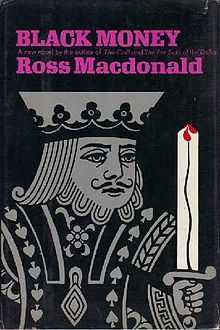Black Money

Black Money is a novel by US American mystery writer Ross Macdonald. Published in 1966, it is, according to Matthew Bruccoli and other critics, among the most powerful of all Ross Macdonald's novels. It was his own personal choice as his best book.[citation needed]
Plot summary
The plot is typically convoluted: the jilted boyfriend of wealthy Virginia Fablon hires Lew Archer to investigate the background of her inamorata, one Felix Cervantes, presently her husband. The resulting inquiries take the reader through levels of society from the homeless to the wealthy, a canvassing seen in other Macdonald novels. Except for brief forays into Las Vegas—the title refers to cash skimmed by casino operators to avoid taxes—and the environs of Los Angeles, the action takes place around Montevista, in private clubs, homes, clinics, the academy, and seedy and luxurious hotels; the implications, however, reach beyond California, as the edges of the story extend to Central America and Europe, whose cultures and economies the book sees as inextricably tied to American life.
Style
Written in understated style, with dry wit and occasional aphorisms ("What you do to others you do to yourself. That's the converse of the golden rule") and without the sentimental biases that sometimes mar the author’s other books, Black Money maintains the speed of a thriller at the same time as it manipulates the reader’s understanding of its characters so as to render them icons of their classes and to lay bare their psychological tropes and moral dimensions.[citation needed] In this respect the book owes much of its vision to F. Scott Fitzgerald’s The Great Gatsby (1925), and it is no accident that Fitzgerald is mentioned once in the text itself: Cervantes and Virginia Fablon share something of Gatsby and Daisy Fay Buchanan.[citation needed] As in Fitzgerald, the glittering surface conceals profound corruption.[citation needed] The denouement is darker than Fitzgerald's work, however.
The compression of the writing augments its emotive force, notably in the complex final scene, which, without having the “jolt” (to use the author’s own word) of The Chill (1964), has an accretive force that gives it even greater power—that of tragedy.[citation needed]
| |||||||||||||||||||